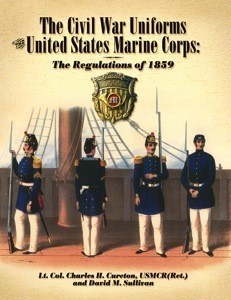CIVIL WAR UNIFORMS OF THE UNITED STATES MARINE CORPS
The Regulations of 1859
Autore: C.H. Cureton, D.M. Sullliavan
Codice: 666013
PREZZO ORIGINALE EURO 78,00 ORA SOLO EURO 50,00
Le uniformi e l’equipaggiamento in dotazione ai Marines durante la Guerra Civile Americana sono praticamente sconosciuti. Nel presente libro gli Autori trattano l’argomento in grande dettaglio attraverso l’analisi di centinaia di ritratti contemporanei di ufficiali e soldati che indossano le uniformi e gli accessori descritti nel regolamento del 1859. A completamento dello studio centinaia di foto a colori di articoli di uniformi e di equipaggiamento originali.
Just as the 1850s can be considered a decade of national divisiveness and discord, 1859 was a year of divisiveness and discord within the Marine Corps Quartermaster Department. The Marine Corps had a new commandant after almost three decades of management by Colonel Commandant Archibald Henderson and he came into the job with different ideas and a different management style, but the change in dress and equipment was necessary regardless as to who commanded the Marine Corps. Civilian fashions in Europe and the United States had changed and by the 1850s the Marine uniform was more anachronistic than fashionable. Equipment was also evolving and military leaders in the Army and the Marine Corps were well aware of these developments. The time had come to make a change and, to its credit, headquarters Marine Corps prompted by the new commandant seized the opportunity. Unfortunately, the unique nature of Marine service with detachments constantly leaving on long sea deployments, others returning, and still others guarding naval establishments, coupled with a new commandant and an inexperienced quartermaster, made the development of the new uniform and equipment more difficult than might otherwise have been the case. The uniform and equipment that emerged was all in one elegant, distinctive, and functional, even if not the product of efficient planning and development. From the perspective of naval operations, the Marine Corps of the Civil War era was heavily committed and rendered significant service. Unfortunately, the contribution of Marines serving ashore and afloat has gone largely unrecognized until the publication of co-author David M. Sullivan's four-volume series on the subject. The objective of The Civil War Uniforms of the United States Marine Corps: The Regulations of 1859 was initially conceived to put a face on the officers and enlisted men of the Civil War era Marine Corps by bringing together the many mostly unpublished images of officer and enlisted Marines photographed between 1859 and 1875. Where possible, the officers and Marines in the images are identified by name and service history. Rather then simply present the photographs as portraits, the decision was made to organize the images according to the dress and equipment being worn. In addition to being able to determine the extent to which the 1859 regulations are a reliable guide to what was actually being used, this decision gave the authors the opportunity to incorporate many of the surviving examples of uniforms and equipment held in various museums and private collections. The uniforms, weapons, and equipment became the basis for arranging the photographs, consequently the chapters follow the precise subject matter arrangement of the 1859 Regulations for the Uniforms and Dress for the Marine Corps of the United States, October, 1859. Each chapter begins with the text pertaining to that section along with the 1859 publication s original illustrations. The man appointed as Quartermaster of the Marine Corps who would oversee the development of the 1859 uniform and equipment was Major Daniel J. Sutherland, who came to the assignment in 1857 with minimal experience having served only two years as assistant quartermaster. The Quartermaster Department itself had always been small and was the creation of Captain Elijah J. Weed in the early 1820s. Breveted captain in November 1828, Weed instituted the practice of having selected lieutenants assigned as assistant quartermasters until the position was made official on 1 July 1834. Augustus A. Nicholson was one of these officers and, as a brevet captain in July 1834.....
INGLESE
475 foto a colori e in bianco e nero
296
22 x 28
si


